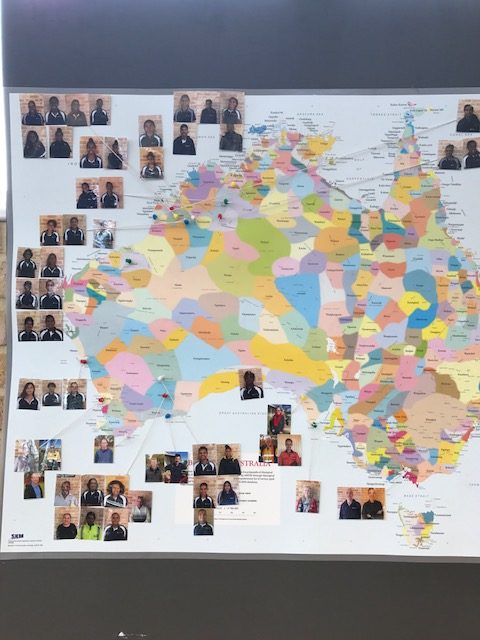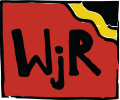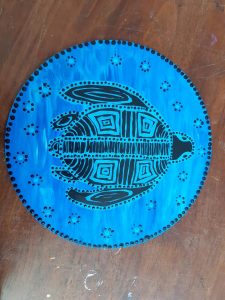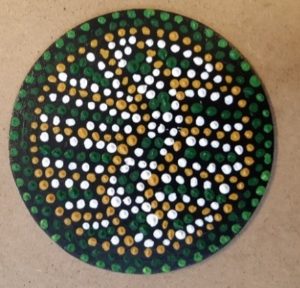Culture
Culture
Aboriginal and Torres Strait Islanders are the First Peoples of Australia and have occupied the lands and waters for millennia. Aboriginal Australians are the oldest continuing culture in the world, with current research estimating over 60,000 years and made up of many different group, each with their own culture, language, beliefs and practices. In Australia there are over 250 Indigenous languages, including 800 dialects.
Aboriginal peoples come from all areas of mainland Australia, including Tasmania and other islands. Torres Strait Islanders come from the region located between the tip of Cape York and Papua New Guinea and is made up of over two hundred islands.
Aboriginal and Torres Strait Islander peoples’ ways of knowing and being in the world are intimately connected to the land and waters. Connection to land is essential to the continued cultural survival of Australia’s First Peoples as well as their economic and social development.
(Source: AIATSIS)

Australian Institute of Aboriginal and Torres Strait Islander Studies
AIATSIS is Australia’s only national institution focused exclusively on the diverse history, cultures and heritage of Aboriginal and Torres Strait Islander Australia.
Based in Canberra, AIATSIS has been operating since 1961 and cares for a collection of over 1 million items relating to Aboriginal and Torres Strait Islander history and culture.
AIATSIS provided cultural education resources, conducts ethical research, publishes books and has an extensive online collection for you to explore.
National NAIDOC Week
National NAIDOC Week celebrations are held across Australia in the first week of July each year, to celebrate and recognise the history, culture and achievements of Aboriginal and Torres Strait Islander peoples. NAIDOC Week is an opportunity for all Australians to learn about First Nations cultures and histories and participate in celebrations of the oldest, continuous living cultures on earth.
Indigenous.gov.au
This website is designed to connect Aboriginal and Torres Strait Islander people with Australian Government policies and programs and raise awareness about the initiatives that affect them most.
The site shares news and events as well as stories from individuals, communities and organisations across Australia. They are real stories about Aboriginal and Torres Strait Islander people, the challenges and opportunities facing them, and the successes and achievements being demonstrated every day.
Australian Human Rights Comission
The Australian Human Rights Commission is an independent statutory organisation, established by an act of Federal Parliament. We protect and promote human rights in Australia and internationally. The Australian Human Rights Commission is committed to Aboriginal and Torres Strait Islander social justice, to ensure the rights of Indigenous Australians.
The Aboriginal and Torres Strait Islander Social Justice Commissioner is June Oscar AO, a proud Bunuba woman from the remote town of Fitzroy Crossing in Western Australia’s Kimberley region.
Oxfam Australia
Oxfam Australia has a strong, 47-year history working as an ally with First Nations communities — supporting health services, campaigns, political empowerment and more — and we’re incredibly proud of the achievements of our First Peoples team.
Oxfam is committed to the motto “First Peoples Justice – Stand with First Peoples for a just and equal future for all”, which acknowledged that despite 65,000 years caring for People and Country, today the First Peoples of Australia are too often excluded from the resources of their own country.
By calling for First Peoples justice, Oxfam’s aim is to undo systemic inequality, challenge injustice, and achieve the change the First Peoples of Australia want to see.
ANTaR
ANTaR is a national advocacy organisation dedicated specifically to the rights – and overcoming the disadvantage – of Aboriginal and Torres Strait Islander people.
ANTaR is an independent, national network of organisations and individuals working in support of justice for Aboriginal and Torres Strait Islander peoples in Australia. ANTaR is an independent non-government organisation and is non-party-political.
Central to ANTaR’s activities has been the Sea of Hands. Over 300,000 Australians have put their signatures on a hand in the Sea of Hands and helped in its installation in locations around Australia.
Gambay - First Languages Interactive Map
First Languages Australia is working with regional language centres nationally to develop a map of Australia’s first languages that reflects the names and groupings favoured by community.
Language centres have provided maps for their regions to be collated into this interactive map of languages and language families. Some regions have chosen to group related languages in colour to help with the sharing of language resources. The information about each language can be shared using its ‘share’ button.
Gambay has been designed and produced in a way that allows language centres and communities to update information as they require. To date, the language centres listed below have contributed to this map.
Gambay means “together” in the Butchulla language of the Hervey Bay region in Queensland. The ‘gam’ in Gambay has the same sound as the ‘gam’ in ‘gammon’, and ‘bay’ sounds the same as it does in Australian English. This title has been provided by Joy Bonner, Butchulla Language Program.
Map of Indigenous Australia
The AIATSIS Map of Indigenous Australia is available in digital and to purchase in hardcopy format. This map attempts to represent the language, social or nation groups of Aboriginal Australia. It shows only the general locations of larger groupings of people which may include clans, dialects or individual languages in a group. It used published resources from the eighteenth century-1994 and is not intended to be exact, nor the boundaries fixed.



